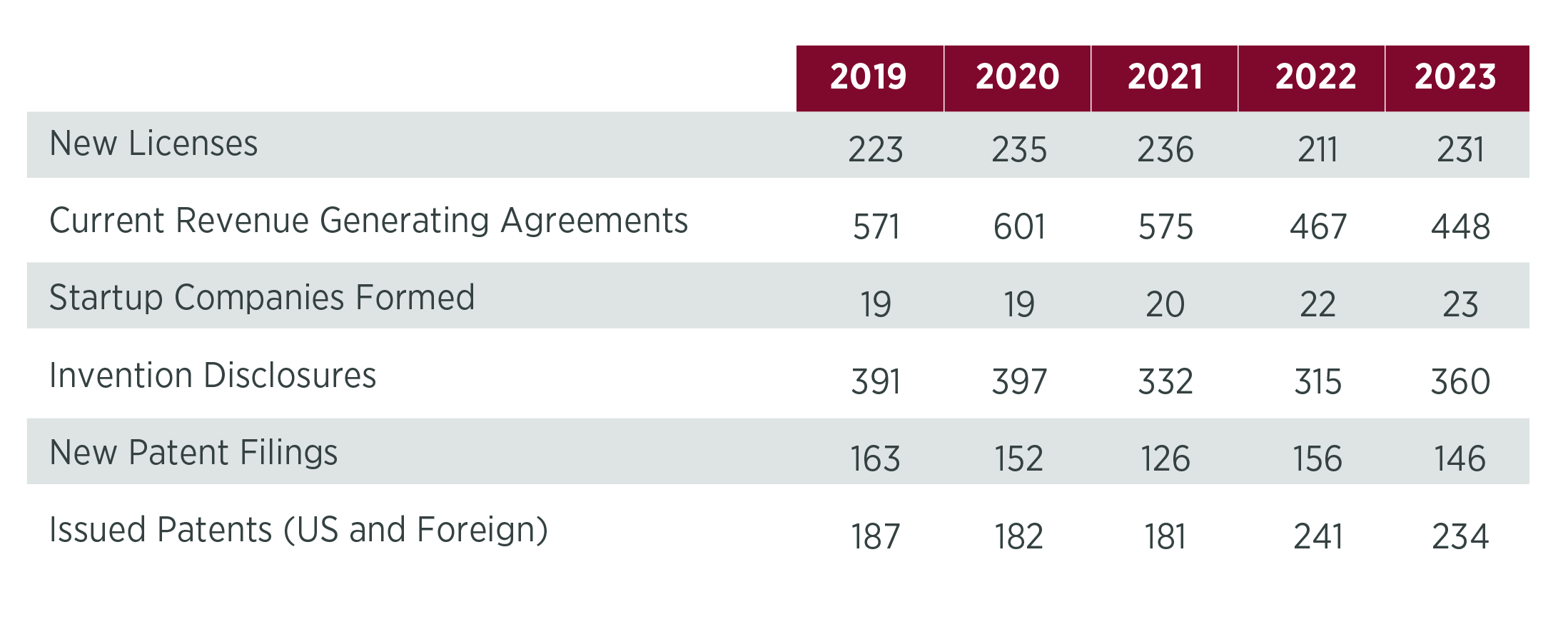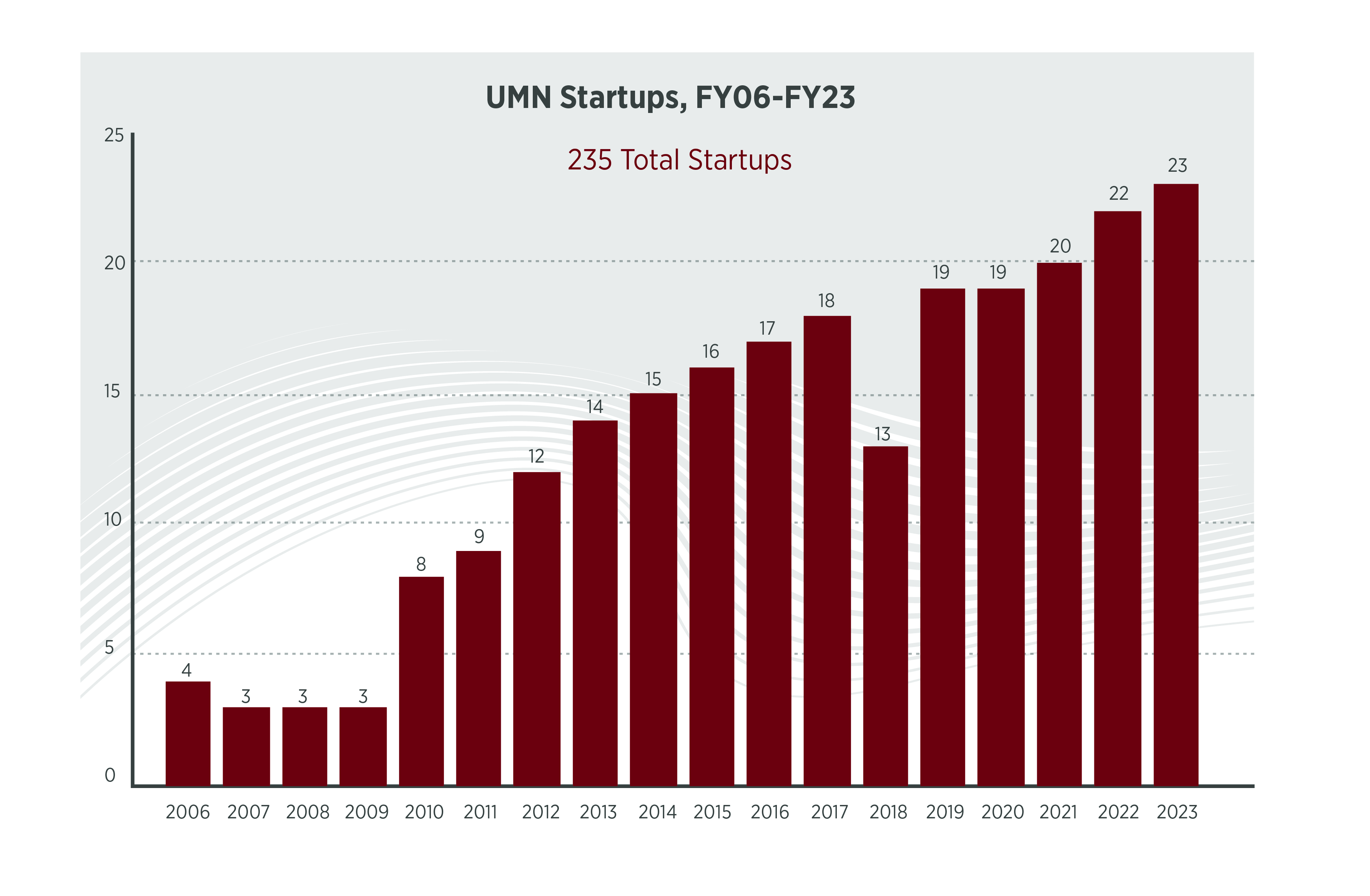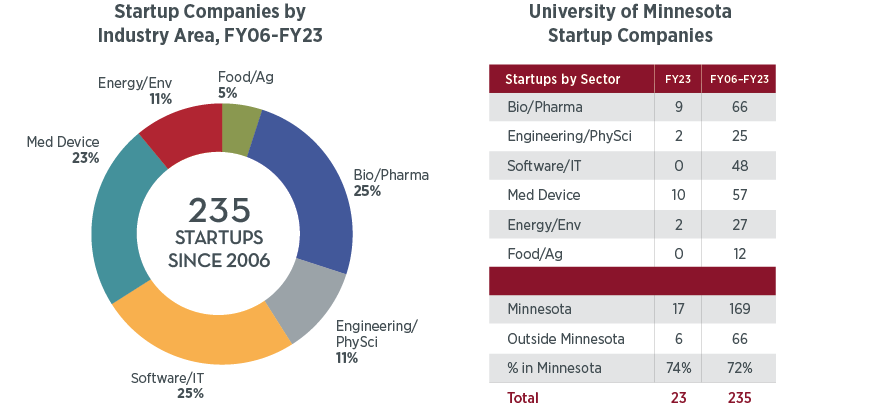
The University of Minnesota launched a record-breaking 23 startup companies in fiscal year (FY) 2023, the result of a growing research portfolio, an increasingly entrepreneurial faculty culture, and years of careful program growth and refinement by the teams at U of M Technology Commercialization (Tech Comm) and its Venture Center as they work to successfully shepherd U of M innovations to market.
“We didn’t just wake up one day and find ourselves to be the largest creator of startup companies in Minnesota,” said Rick Huebsch, Associate Vice President for Research, Technology Commercialization. “We’ve spent years fine tuning the process and building the ecosystem, and we’re fortunate to have access to researchers who are embracing entrepreneurship and partners at the University and beyond that can help us build innovation. It takes a village to turn research innovation into a commercial success and it feels like we have many of the right pieces in place.”
Some of the exciting startups launched in FY 2023 include Carba, which is commercializing a process that converts plant waste carbon dioxide into solid carbon and sequesters it underground for thousands of years, and VOCxI Health, a U of M collaboration with Boston Scientific to develop a non-invasive breath sensor that measures health status at home or anywhere.
Existing U of M startups also had a successful FY 2023. Niron Magnetics, launched in 2014, received $17.5M from the U.S. Department of Energy to scale up prototyping of its sustainable permanent magnets, and has raised more than $100M in total funding with plans to build a full-scale production facility. RoundtableRx, a nonprofit that distributes unused medications to individuals in need, was awarded $900,000 for its work over the next two years by the State of Minnesota.
Venture Center Offers Key Startup Support
Some of the “right pieces” are found in Tech Comm’s Venture Center, which identifies U of M technology and ideas that are best suited to reach the market through a dedicated startup company, rather than licensing them to an existing company, and provides tailored advice and resources to help them launch.
The 235 U of M startups spunout since 2006 have a survival rate of over 75% and have attracted more than $1.8 billion in investment capital, IPOs and acquisitions. More than 70% of U of M startups have been founded in Minnesota
The Venture Center’s Discovery Launchpad program provides coaching and incubation, and this year helped 31 U of M companies develop business and fundraising plans, market-fit analysis and initial customer discovery. Discovery Launchpad startups often receive technical expertise, management advice and industry-specific connections from Tech Comm’s Business Advisory Group, which includes more than 400 business-savvy members who provide broad and individual counsel.
Another Venture Center program, Discovery Capital, uses revenue generated by previous U of M technologies to facilitate and stimulate investments, drawing in other investors through matching seed stage opportunities. In FY 2023, Discovery Capital set a new record of six investments totaling $1.6M.
Startups Are Part of Broader UMN Technology Commercialization Work
Startup creation is one aspect of the broader work of technology commercialization, the process of transferring discoveries from lab to marketplace and a significant way that research universities like U of M contribute to our economy and our society. Licensing inventions to an established company interested in the technology provides another important pathway to bring U of M innovations to Minnesotans and the world.
Some discoveries the University is historically known for include the Honeycrisp apple and 27 other apple varieties, the anti-HIV drug Ziagen, the airplane black box recorder and the portable pacemaker. Today, U of M researchers continue to lead in the invention and commercialization of cold hardy fruits, disease diagnostics and treatments, and medical devices, but also in genomics, sustainable materials, sensors, artificial intelligence and data analytics, and many other areas critical to pressing concerns such as climate change, water quality, food and agriculture, and health care.
Other “Right Pieces” in Place
The U of M’s Technology Commercialization team views itself as an end-to-end operation, meaning it helps inventions from the idea stage to the market stage, whether their path is via a startup company or more traditional licensing arrangements. Tech Comm staff provide licensing and intellectual property expertise and their MnBridge and Early Innovation Fund programs help inventors develop promising U of M technologies to a stage where they are more attractive to investors or corporate partners.
Beyond its own programs, Tech Comm also encourages U of M inventors to develop their ideas through MIN-Corps, advance their technology with funding from the Office of Discovery and Translation, accelerate the development of startups through MN Venture Builders, pitch to investors through MN Cup, and develop technologies in partnership with small businesses through federal SBIR/STTR grants facilitated by MNSBIR.
Collectively, all of these moving pieces are part of why U of M is typically in the top 10 among U.S. public universities for key technology commercialization metrics: deals, disclosures, and startups. In FY 2023, U of M was awarded 234 new US and foreign patents--a level second only to the previous year’s record 241 patents--received 360 new invention disclosures, executed 231 licensing deals, submitted 146 first patent filings, and earned licensing revenue of over $16M, much of which is reinvested in research and innovation at the University.
Additional technology transfer metrics are available on the statistics page.
Scaling Up
“Looking ahead, we’re not just hoping to match our current success, we want to scale up to the next level,” said Huebsch. “To do this, we’re planning to kick off several new gap funding programs this fall, to be supported by donors and investors who are excited about investing in innovation for societal impact and benefit.”



- Categories:
- Business and Management
- Entrepreneurship




